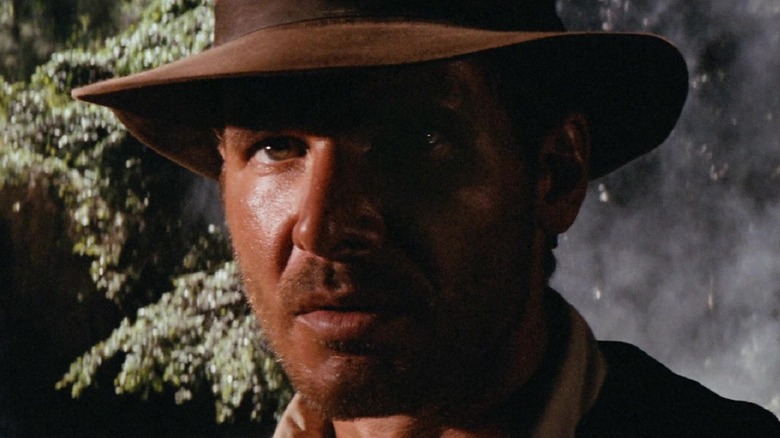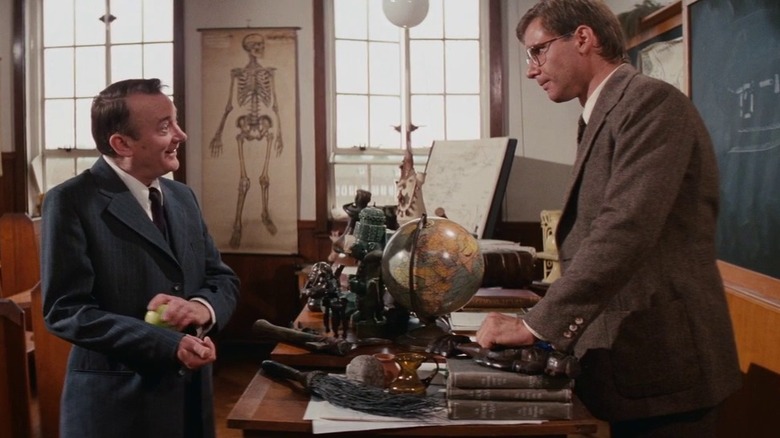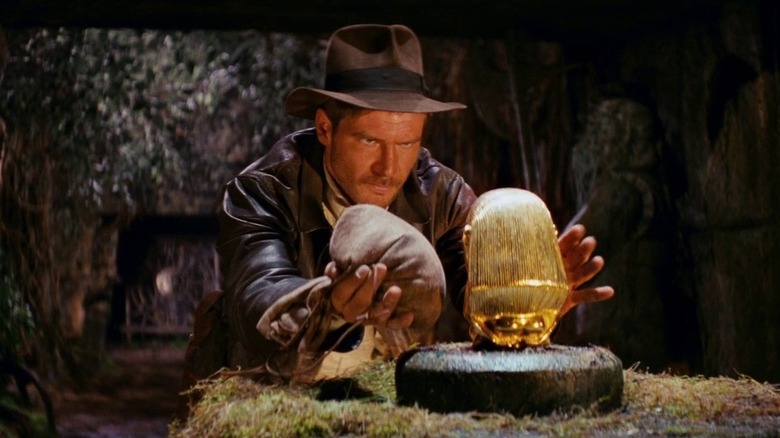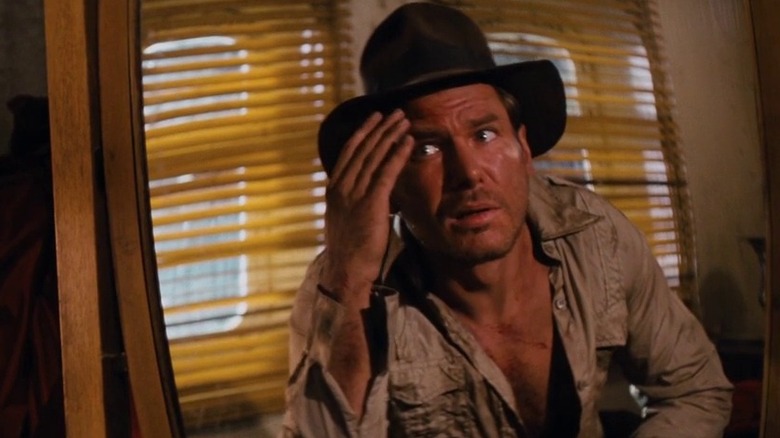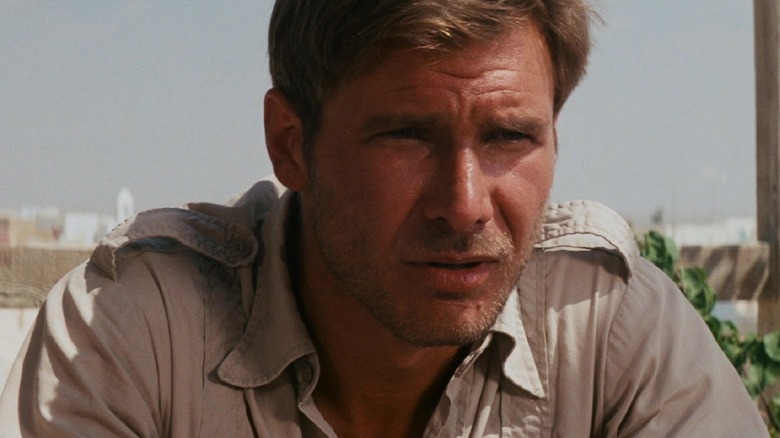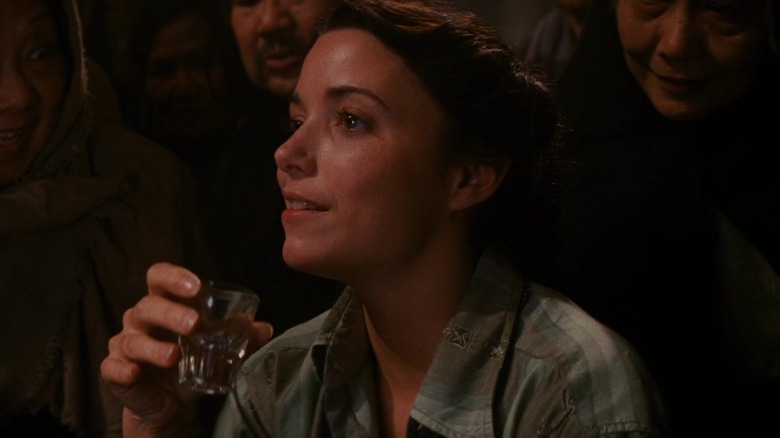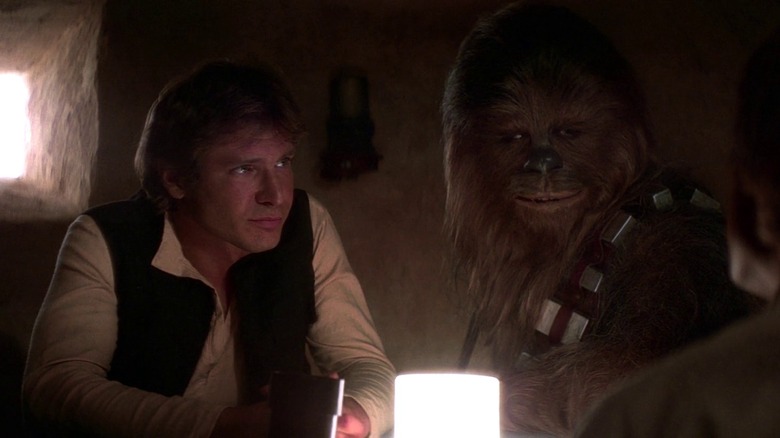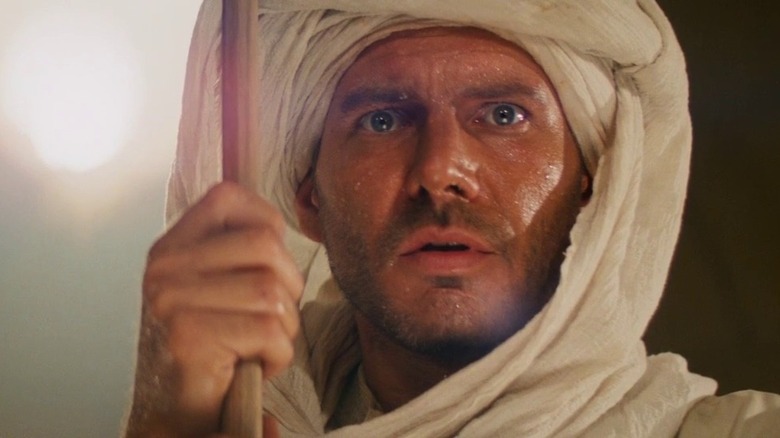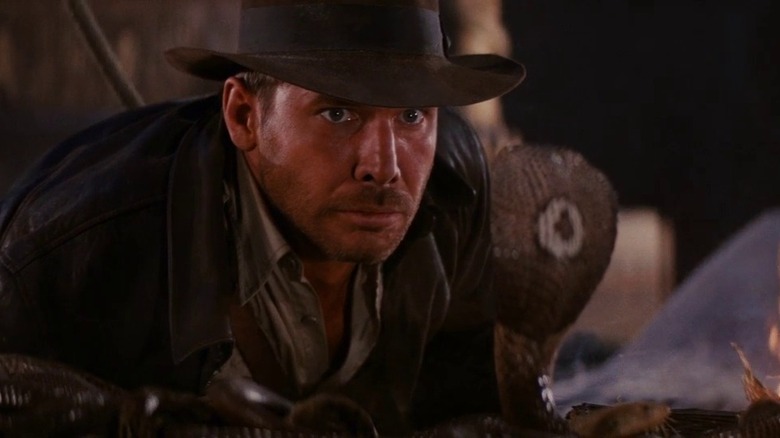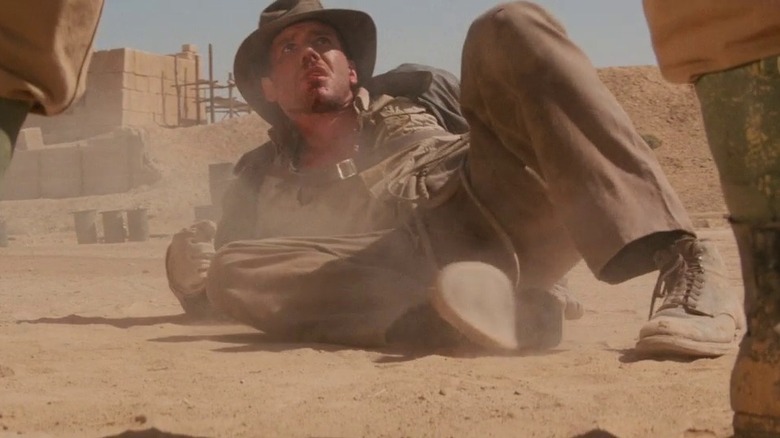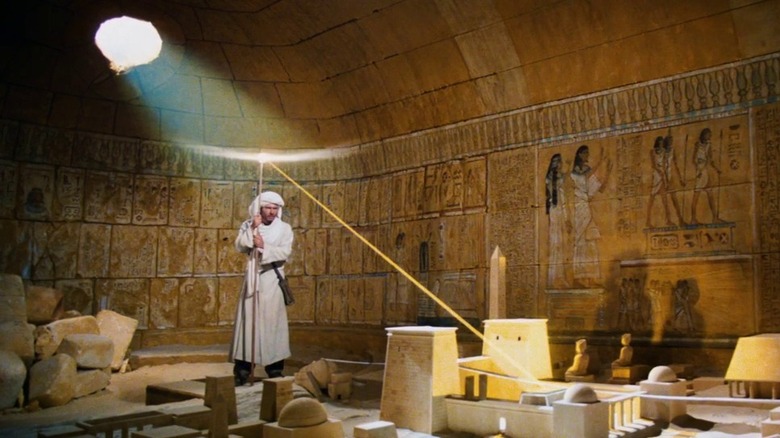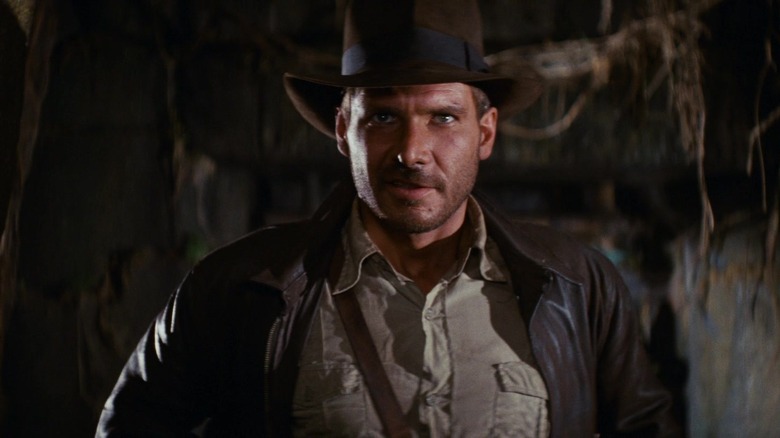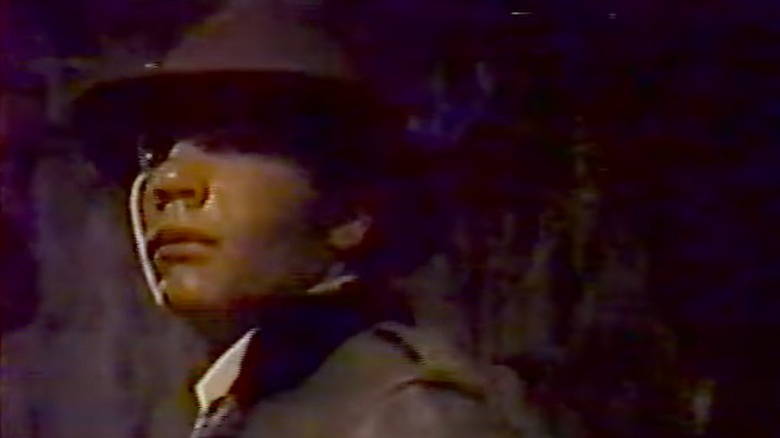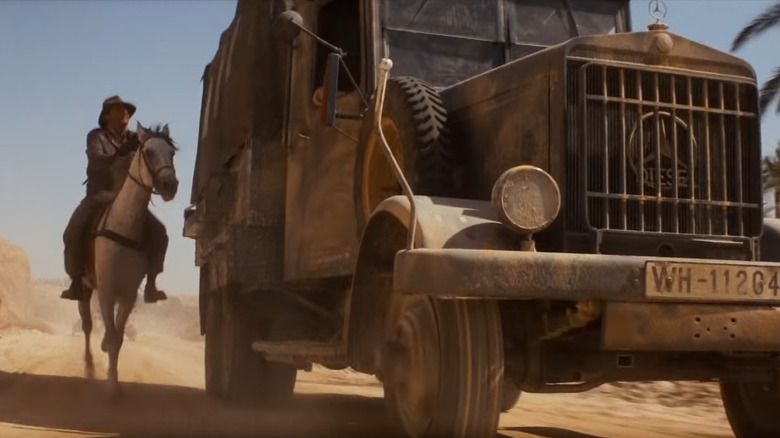What It Was Really Like To See Raiders Of The Lost Ark In 1981
The iconic, instantly recognizable "Indiana Jones" theme music accompanied Harrison Ford as he walked onstage. The year was 2016, and the occasion was the American Film Institute's Life Achievement Award ceremony in honor of John Williams — the legendary film composer behind "Jaws," "Star Wars," and, of course, "Indiana Jones." Ford himself received the award in 2000, but it was during Williams' ceremony — as the rousing, signature Indy theme filled the air — that Ford approached the microphone and gruffly said, "Damn music follows me everywhere."
His annoyance was in jest, but he spoke facts, citing that Williams' music is forever attached to any appearance Ford makes and that it's an honor to be associated with such marvelous work. Back in 1981, though, when the first "Indiana Jones" film debuted in theaters, Ford could never have predicted how his role in Steven Spielberg's new action-adventure picture would come to define his career — nor could anyone else. Audiences knew Ford as Han Solo. They had no clue who this Indiana Jones fellow was. In fact, the movie, "Raiders of the Lost Ark," didn't even bear the character's name at the time.
What was it like to settle into a movie theater in 1981 being familiar with Ford and perhaps knowing Spielberg's name, but being completely unacquainted with Indiana Jones? How did this new character win over audiences to propel its franchise to become the phenomenon it is today? Join us as we take a look back on this iconic blockbuster.
Critics struggled to find words to convey their approval of the movie
Upon witnessing the set pieces and spectacle of "Raiders of the Lost Ark" — balanced with its careful storytelling and well-developed characters — most critics emerged from the theater having had an ethereal experience. In their reviews, they went beyond simply recommending the film — they used an abundance of the most positive adjectives in the dictionary to describe their adoration for it.
On "Sneak Previews," a television program produced by WTTW in Chicago, critic Roger Ebert was visibly enthusiastic in his appraisal of the film. Ebert called it "the most exciting and entertaining movie to come along in a long time," and a "nonstop roller coaster ride." He elaborated, "It's fun for a lot of reasons, but the best reason is the film's inexhaustible supply of dangerous situations. It never lets go." Ebert claimed "Raiders of the Lost Ark" included "the best chase scene I've ever seen in a movie." High praise from a man who has seen a lot of movies.
Ebert wasn't alone in his hyperbolic approval. Vincent Canby of The New York Times called it "one of the most deliriously funny, ingenious and stylish American adventure movies ever made." For many critics, "Raiders of the Lost Ark" wasn't just perceived as a good movie, but as a new peak of the filmmaking art form itself.
Raiders was a comeback for Steven Spielberg after a failure
Today the name Steven Spielberg comes with an attached reputation of some of the best movies of the past five decades. Respected as a director and revered as an artist, audiences can rest easy and generally have an elevated expectation of a movie's quality if they know Spielberg is at the helm.
In 1981, though, Spielberg wasn't necessarily the guaranteed hitmaker he is today. At that time, audiences paying attention to his career may have known his name as the director of "Jaws" or "Close Encounters of the Third Kind." While these had both been big successes for Spielberg, the film that preceded "Raiders of the Lost Ark" — 1979's farcical war film "1941" — had been a box office disappointment. In reviewing "Raiders of the Lost Ark," Roger Ebert was quick to note that Spielberg "bombed a year and a half ago very badly with 1941." That was still fresh in the public's mind, and birthing Indiana Jones was a chance for Spielberg to renew his reputation as the king of the blockbuster, with Ebert affirming that Spielberg was "back on the track now" with "Raiders of the Lost Ark."
Other critics agreed, including Stephen Klain of Variety who said, "Spielberg has harnessed a perfect balance between escapist fun and hard-edged action, and the film is among the best-crafted ventures of its kind." While "1941" was a blip, it proved to be a necessary failure for Spielberg, who would go on to make some of the biggest films of his career almost immediately after.
The film's marketing talked a big game
Now known for their long tenure in the film industry, back in 1981 "Raiders of the Lost Ark" director Steven Spielberg and producer George Lucas were still early in their careers. Nonetheless, they still had some impressive items on their collective résumé that the film's marketing leveraged to its advantage.
Promotion for "Raiders of the Lost Ark" was forthright about its intentions and quite blunt in what it promised to viewers. One poster touted, "The creators of 'Jaws' and 'Star Wars' now bring you the ultimate hero in the ultimate adventure." No pressure, but those are some pretty big shoes to fill. By and large, though, "Raiders of the Lost Ark" seemed to do good on the extremely high expectations it set for its audience. Spielberg and Lucas proved themselves to be masterful collaborators, with the 1981 film and the successive "Indiana Jones" franchise installments today being just as pertinent to their filmographies as the other massive accomplishments they were already known for.
Harrison Ford was proud of the movie
As an artist, it can be scary to finish creating something, and not know how others will perceive the work. "Raiders of the Lost Ark" would go on to become an international success over the course of the next 40 years, spawning an entire extended universe of projects across a vast narrative timeline. When it wrapped production prior to its 1981 release, though, no one knew what the public would think of it.
As far as Harrison Ford was concerned, he was proud of his work. Speaking to a camera crew seemingly moments after completing the shoot — a brief, profound moment in time when he had imprinted his stamp on Indy's character but the world had yet to meet him — Ford said, "I'm very happy with what we did and I'm glad it's over. It's the toughest job I've ever had." Little did he know he'd have plenty more "tough" work as Dr. Jones in the future. What would he think if he was told it was only just beginning?
It wasn't until seeing the finished movie that Karen Allen saw Spielberg's vision
Karen Allen — who portrayed Marion Ravenwood in "Raiders of the Lost Ark" — had a lightbulb moment when she saw the finished movie for the first time. "I was blown away by it when I saw it," she said in the 2003 documentary "Indiana Jones: Making the Trilogy." Allen shared, "I think when we finished the film, I was a little puzzled by what we had done. When I went to the theater and sat down, I was like, 'Oh.' I got it instantly. I mean, I saw what [Steven Spielberg] was doing and I saw the film that he was making and I knew it was really good. I knew it was something people would respond to."
With a film as ambitious as "Raiders of the Lost Ark," this disparity makes sense. There are so many moving parts that make up the whole of its filmmaking process — from the choreography of huge action sequences to the globetrotting changes in location. While the finished product seems grand and spectacular, it's perfectly reasonable for Allen to not have been able to picture Spielberg's intangible vision in the minutiae of its day-to-day filming.
It was hard not to compare Raiders of the Lost Ark to Star Wars
With George Lucas so prominently acknowledged as a creative mind behind "Raiders of the Lost Ark" — and with Harrison Ford starring in its lead role — some audience members found it difficult to not compare and contrast it with their previous work in a galaxy far, far away. By 1981, Ford had already played Han Solo in 1977's "Star Wars" — which Lucas directed, wrote, and produced — and 1980's "The Empire Strikes Back" — for which Lucas wrote the story and served as executive producer. Perhaps less prominently in the public eye — but nevertheless also shared between both movie worlds — were writer Lawrence Kasdan and composer John Williams.
All this to say — both behind the camera and in front of it — "Raiders of the Lost Ark" had a lot in common with "Star Wars," and it was difficult for audiences to not compare the two. In a rare negative review of "Raiders of the Lost Ark," Lou Lumenick wrote in The New York Post in 1981 that such a comparison was "unfair," even if "the temptation is there." Contrasting the two movies, Lumenick said, "'Raiders' is a much more modest undertaking, an old-fashioned adventure story that eschews science-fiction prytechnics [sic] until the very end."
It felt like a tribute to a bygone era of filmmaking
Nostalgia may be at the forefront of many modern Hollywood projects, but it's nothing new. It seems that every generation loves a good callback to yesteryear, and 1981 audiences were no different. "Raiders of the Lost Ark" intentionally leaned into the stylings of grand serialized adventures — a genre that had long since gone away by the '80s and one that audiences were thrilled to see replicated here.
Writer Stephen Klain hailed in Variety that the film "is the stuff that raucous Saturday matinees at the local Bijou once were made of, a crackerjack fantasy-adventure that shapes its pulp sensibilities and cliff-hanging serial origins into an exhilarating escapist entertainment that will have broad-cased summer audiences in the palm of its hand."
In The New York Times, reviewer Vincent Canby suggested that "Raiders of the Lost Ark" took things one step further, being a manifestation of a collective nostalgia toward its vintage subject matter in a way that had never previously existed. Canby wrote, "It is an homage ... that transcends its inspirations to become, in effect, the movie we saw in our imaginations as we watched, say, Buster Crabbe in 'Flash Gordon's Trip to Mars' or in Sam Katzman's 'Jungle Jim' movies." In Fantastic Films magazine, writer Douglas Rice celebrated "Raiders of the Lost Ark," saying, "They didn't think that kind of film could be made anymore, because nobody would buy it; but everybody is buying it. They love it."
One prediction: Indiana Jones will be forgotten
Not everyone had nice things to say about "Raiders of the Lost Ark." While the reception of the film was overwhelmingly positive, it wasn't everyone's cup of tea. Upon seeing the film in 1981 and comparing it to previous outings from Steven Spielberg and George Lucas, reviewer Lou Lumenick wrote in The New York Post, "Raiders makes for a very entertaining junk-food movie that will be forgotten long before either man's previous work." He continued, "Ford is pleasantly self-effacing — if hardly memorable — as Indy." In 2011, Lumenick reflected on his initial review and lamented his negativity, having changed his mind about the movie in the interim three decades.
Back in 1981, Pauline Kael of The New Yorker had high hopes for Spielberg and Lucas' futures — "If anybody has a chance to turn movies around, it would seem to be these two (or Coppola)," she wrote — but she was less forgiving about "Raiders of the Lost Ark" in particular. Kael noted, "Spielberg's technique may be too much for the genre." She complained that the opening scene had "the biggest damn boulder you've ever seen" and was "so thrill-packed you don't have time to breathe — or to enjoy yourself much, either." It is perhaps most surprising that Kael called John Williams' score "pounding" and "klunky" — a statement many fans might consider as blasphemy, given how beloved the music has become.
Raiders pushed the boundaries of its PG rating
If "Raiders of the Lost Ark" was released today, the Motion Pictures Association of America (MPAA) would likely give it a PG-13 rating. The intense action sequences, violent fights — and sometimes gruesome visuals — are par for the course of a PG-13 movie. In 1981, though, PG-13 didn't exist. While certainly not tame enough to be rated G, "Raiders of the Lost Ark" also wasn't so far gone that it warranted being rated R. Or was it?
Variety felt that the movie had "surprisingly explicit violent action and bloodletting for a PG-rated entry and at least one scene (when the Nazis open the ark, liberating divine fury in the form of special beings that melt the defilers' faces and explode their heads into smithereens) that would be attention-getting in an R-rated pic."
So it was too much for PG, but not enough for R. If only there was some sort of in-between barrier rating. The issue was finally rectified three years later, in part thanks to Indy. The Hollywood Reporter pointed out that in May 1984 when "Indiana Jones and the Temple of Doom" debuted, it met the same chorus as its predecessor of being too violent for a PG movie. As a result, MPAA introduced PG-13 in July 1984, and the first movie to receive the distinction was "Red Dawn" the next month (via History).
The pre-production artist was thrilled with how closely the movie matched his artwork
Today, Indiana Jones is regarded as a classic figure of Hollywood history — even his silhouette is recognizable. The look of Indiana Jones as an individual has effectively become its own archetype that countless other movies in the wake of "Raiders of the Lost Ark" have attempted to duplicate. You can describe a character in a new movie as "an Indiana Jones-type figure" and the person listening immediately knows what you mean. In 1981, though, Jones was far from being a template — he didn't exist at all.
Jim Steranko shared in Fantastic Films magazine that he was tasked with developing concept artwork for the film, and by extension, the character of Indy himself, even before Harrison Ford was attached to the project. "The first 'Raiders' painting I did established the character of Indiana Jones," Steranko said. "There was really no actor discussed at this point, at least not with me. I was told to produce a rugged, pulp-type hero who could appear to achieve the kind of heroics that Indiana Jones is involved in."
Steranko informed the look of the character and the feel of its fictional world but wasn't present on set. He remembered Carol Titleman from Lucasfilm telling him, "You wouldn't believe how close the paintings are to the material on the screen." When Steranko finally saw the film, he was excited by how much his art influenced what Steven Spielberg had shot.
Harrison Ford was compared to Humphrey Bogart
With "Raiders of the Lost Ark" being the vehicle that introduced Indiana Jones to the world — not only did filmmakers have to pioneer and build the mythos of their movie world from the ground up — but critics were also faced with the task of describing the movie and its lead character to potential audience members who had never heard of Indiana Jones before. How does one do that?
Critic Roger Ebert likened Ford to Humphrey Bogart — a Hollywood leading man about a generation or so Ford's senior — known for "Casablanca" and "The African Queen," among other movies. Ebert said, "Harrison Ford plays a much different character here than he did in 'Star Wars.' He's older. He's more ragged. He's more like Humphrey Bogart, and they give him the Bogart look with that hat and three-day beard. He's right out of 'The Treasure of the Sierra Madre' (a 1948 Bogart-starring film)."
Two young fans remade Raiders in their garage
Two kids loved "Raiders of the Lost Ark" so much that they couldn't contain their excitement. To 12-year-old Eric Zala and 11-year-old Chris Strompolos, seeing it in 1981 wasn't just an afternoon at the movies —it was an awakening of a passion for filmmaking. "I wanted nothing more [than] to be in that world and wear that hat, put on that jacket, and have a bullwhip by my side," Strompolos reflected with Portland Mercury in 2008. Inspired by what they had seen, Zala and Strompolos committed to filming their own remake of "Raiders of the Lost Ark."
It wasn't just a pipe dream, either. Zala and Strompolos spent the next seven summers filming their remake, annually asking every Christmas and birthday for items they could use as props. They recreated the movie in its entirety, using the best resources and makeshift sets that they could find.
Zala and Strompolos' movie came to be known as "Raiders of the Lost Ark: The Adaptation," and yes, even Steven Spielberg has seen it (via The Austin Chronicle). There was also a documentary made in 2015 tracing its history called, "Raiders!: The Story of the Greatest Fan Film Ever Made." Others may claim to love Indy, but few have taken this adoration as far as Zala and Strompolos.
Indy topped the box office
Not only did "Raiders of the Lost Ark" score superlatives of every fashion in terms of critical reception, but it was also a box-office smash — ultimately becoming the top-earning film of 1981 worldwide with over $212 million. What's more, the number-two movie of the year didn't come anywhere close to dethroning it. 1981's runner-up, with $119 million, was "On Golden Pond," a drama starring Katharine Hepburn, Henry Fonda, and Jane Fonda.
Arguably the fiercest immediate competition to "Raiders of the Lost Ark" was "Superman II," which debuted just one week after Indy. While today we can perceive how "Raiders of the Lost Ark" became a phenomenon, prior to its release nothing was certain. On paper, both "Raiders of the Lost Ark" and "Superman II" could be similarly described as summer blockbusters — even if thematically they're very different. The New York Post predicted adults would like "Superman II" more, perceiving "Raiders of the Lost Ark" to be more kid-centric. Even as the follow-up to a well-known superhero movie, the Christopher Reeve-starring sequel still lagged behind, eventually becoming 1981's third-highest earner with $108 million.
